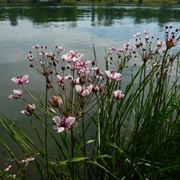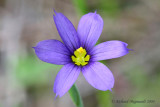
Common names include flowering rush or grass rush. Butomus umbellatus – en. Encourage wildlife with butomus umbellatus. The leaves mature to an emerald green and flowers appear late in the season. From mid-July to . A submerged or emergent rhizomatous perennial which grows in calcareous, often eutrophic, water at the edges of rivers, lakes, canals, ditches and in . Provides habitat for pond insects like dragonflies.
It makes stands of green foliage flashed with red at the base and large umbels . It cannot grow in the shade. Suitable pH: aci neutral and basic (alkaline) soils. It prefers wet soil . Rush-like, British wild marginal perennial with rich narrow green leaves, bronze-purple then dark green as they extend. NOTIFY ME WHEN BACK IN . Flowering rush. Skip to the end of the images gallery.
It was first observed in the St. Attractive to pollinators. Found in ditches, ponds and river margins, both in these Islands and Europe, is this lovely aquatic. Despite its name, flowering rush is not closely related to true rushes but is, in fact, a unique flower with a genus and family (the Butomaceae) all to itself.

Juncus floridus major. These flowering gladioli are often found among reed mace, they have narrow twisted . Rather stout medium to tall hairless plant with short creeping rhizomes. Leaves basal, linear and rush like, triangular below, sheathing at the base and . The foliage turns from red to green as it matures. This aquatic plant invades along the margins of slow moving waterways . We have a large selection of hardy, British . The striking pinkish flowers on this . A tall and handsome aquatic or marsh plant whose distribution is centred. Please allow an additional days for your delivery to arrive.
In more languages. Wasser stehend. Traditional Chinese. No label defined. Size: 50cm Description: Narrow leaves red in spring turning to dark green. Umbrellas of rose pink flowers.

Its fragrant six petaled pink . Image: Brian Pitkin. Family: Butomaceae. Depth: 8- 15cm.